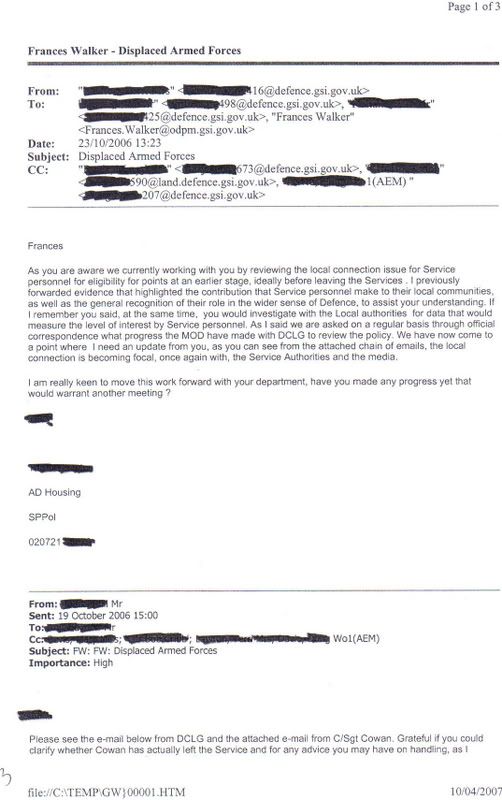Vim_Fuego My intentions are to advice service peronnel on the pit falls of buying a house in the present climate. As was placed in the national papers today, some people are taking out mortgages over 9 time their earnings.
The following is something I read recently, "Ignorance is nothing to be ashamed off - But its nothing to be proud off either!
The following was sent to me today by the Shadow Defence Minister. It's the Tory Parties state of the nation report that was launched this week. As you will see they cover the area of home ownership amongst service personnel and their future look forward. The document is very long so I have placed just a small amount on here. If anyone would like the full document then please email me.
Regards
Hitback
Forces Families Mark Harper MP
In the Army, three quarters of personnel live in Army accommodation. In the ranks home ownership is just 9%. DT_Xtremez_03:
DT_Xtremez_03:
Housing and accommodation
The Ministry of Defence currently manages 49,000 service family and 150,00single living units, making it Britain's largest property manager4. The quality of this accommodation is graded on a four point scale. Most of the Service Families Accommodation (SFA) is in the top two grades5. However, half of all Single Living Accommodation (SLA) is of the worst standard (see table 1). This problem has been highlighted recently by the media and, in an interview, the Adjutant General, Lt Gen Viggers said “there is still too much accommodation
which is of a poor standard, and is old and is not modern in terms of the way that is fitting for the families.”6 In the 2006 Continuous Attitudes Survey just 40% of soldiers were satisfied with their Army accommodation.
It is not fair to expect our forces to come home from the many operations that they are being asked to undertake to accommodation that most people would find unacceptable. This problem is particularly acute in the Army, where a much higher proportion of personnel are housed in service accommodation (see table 2).
Table 1: MoD Accommodation by grade
Grade Service Families Accommodation (SFA)--Single Living Accommodation (SLA)
1 (good) 27,687 (59%)------------------------------- --- 24,254 (18%)
2 16,916 (36%)---------------------------------------------23,261 (17%)
3 2,089 (4%)------------------------------------------------22,931 (17%)
4 (bad) 139 (1%)-------------------------------------------66,836 (48%)
Total 46,831 137,282
To address this issue there are two things that need to be done. First, and most simply, the quality of accommodation needs to be improved. To be fair to the Government, some progress is being made here. Project SLAM is modernising the SLA, costing some £480 million in the first five years; a further £335 million will be spent in the years 2008/09 to 2012/139. This will upgrade a total of 13,000 single living spaces. The MoD currently intends to upgrade SFA accommodation at a rate of about 900 units a year. At these rates it
will takes decades to get the accommodation up the standards that we would expect, and they must still be maintained at this standard. A recent NAO report noted that “a significant number of Service personnel and their families are likely to be housed in poor quality accommodation for 20 years or more”. We will investigate whether the upgrading process can be accelerated, and at what cost.
The second option is to improve the proportion of service personnel who actually live in and own their own homes. At present only 9% of Army soldiers live in and own their home (compared to 18% of officers)11; 64% of other ranks in the Army have never owned their own home (just 25% for officers). Table 2 shows the proportion of each service occupying service accommodation.
Table 2: Proportion of personnel living in Service accommodation
Service Number paying accommodation charges--Total strength of service Percentage
Royal Navy 14,627------------------------------------------------------39,390 37
Army 78,902-----------------------------------------------------107,703 73
RAF 27,908-----------------------------------------------------48,730 57
The problem that personnel face is that it is very difficult to get onto the housing ladder. When accommodation is already provided, the incentive to buy a home, with all the risks that this involves is not great. However, when a colour sergeant, for example, leaves the Army at the age of 40 he or she does not want to consider getting their first mortgage. In the Continuous Attitudes Survey 37% of responding officers were either fairly or very dissatisfied
with the prospects for buying or even renting a house. This rose to 42% for other ranks. Some service families are leaving the forces and going into hostels. At present local authorities do not need to consider forces families as having a ‘local connection’ for the purposes of social housing. The Conservative Party will investigate if this system can be developed in a way that will support service personnel, but not place an unacceptable burden
on local communities.
The MoD does currently provide a Long Service Advance of Pay (LSAP) worth up to £8,500. This does not go very far in the current housing market and it has failed to keep up with the rise in house prices. This is further compounded by the fact that the LSAP cannot be used to buy properties that are then rented out. This rule is, reasonably, in place to stop personnel using the allowance for their own profit, but it also means that personnel with a high mobility can never take advantage of the scheme and make it onto the housing ladder. These rules need to be reviewed. We will look at ways in which we can encourage and support personnel to get onto the
housing ladder while still serving so that, when they do leave, they have a home and base from which they can start their new life.
The following is something I read recently, "Ignorance is nothing to be ashamed off - But its nothing to be proud off either!
The following was sent to me today by the Shadow Defence Minister. It's the Tory Parties state of the nation report that was launched this week. As you will see they cover the area of home ownership amongst service personnel and their future look forward. The document is very long so I have placed just a small amount on here. If anyone would like the full document then please email me.
Regards
Hitback
Forces Families Mark Harper MP
In the Army, three quarters of personnel live in Army accommodation. In the ranks home ownership is just 9%.
Housing and accommodation
The Ministry of Defence currently manages 49,000 service family and 150,00single living units, making it Britain's largest property manager4. The quality of this accommodation is graded on a four point scale. Most of the Service Families Accommodation (SFA) is in the top two grades5. However, half of all Single Living Accommodation (SLA) is of the worst standard (see table 1). This problem has been highlighted recently by the media and, in an interview, the Adjutant General, Lt Gen Viggers said “there is still too much accommodation
which is of a poor standard, and is old and is not modern in terms of the way that is fitting for the families.”6 In the 2006 Continuous Attitudes Survey just 40% of soldiers were satisfied with their Army accommodation.
It is not fair to expect our forces to come home from the many operations that they are being asked to undertake to accommodation that most people would find unacceptable. This problem is particularly acute in the Army, where a much higher proportion of personnel are housed in service accommodation (see table 2).
Table 1: MoD Accommodation by grade
Grade Service Families Accommodation (SFA)--Single Living Accommodation (SLA)
1 (good) 27,687 (59%)------------------------------- --- 24,254 (18%)
2 16,916 (36%)---------------------------------------------23,261 (17%)
3 2,089 (4%)------------------------------------------------22,931 (17%)
4 (bad) 139 (1%)-------------------------------------------66,836 (48%)
Total 46,831 137,282
To address this issue there are two things that need to be done. First, and most simply, the quality of accommodation needs to be improved. To be fair to the Government, some progress is being made here. Project SLAM is modernising the SLA, costing some £480 million in the first five years; a further £335 million will be spent in the years 2008/09 to 2012/139. This will upgrade a total of 13,000 single living spaces. The MoD currently intends to upgrade SFA accommodation at a rate of about 900 units a year. At these rates it
will takes decades to get the accommodation up the standards that we would expect, and they must still be maintained at this standard. A recent NAO report noted that “a significant number of Service personnel and their families are likely to be housed in poor quality accommodation for 20 years or more”. We will investigate whether the upgrading process can be accelerated, and at what cost.
The second option is to improve the proportion of service personnel who actually live in and own their own homes. At present only 9% of Army soldiers live in and own their home (compared to 18% of officers)11; 64% of other ranks in the Army have never owned their own home (just 25% for officers). Table 2 shows the proportion of each service occupying service accommodation.
Table 2: Proportion of personnel living in Service accommodation
Service Number paying accommodation charges--Total strength of service Percentage
Royal Navy 14,627------------------------------------------------------39,390 37
Army 78,902-----------------------------------------------------107,703 73
RAF 27,908-----------------------------------------------------48,730 57
The problem that personnel face is that it is very difficult to get onto the housing ladder. When accommodation is already provided, the incentive to buy a home, with all the risks that this involves is not great. However, when a colour sergeant, for example, leaves the Army at the age of 40 he or she does not want to consider getting their first mortgage. In the Continuous Attitudes Survey 37% of responding officers were either fairly or very dissatisfied
with the prospects for buying or even renting a house. This rose to 42% for other ranks. Some service families are leaving the forces and going into hostels. At present local authorities do not need to consider forces families as having a ‘local connection’ for the purposes of social housing. The Conservative Party will investigate if this system can be developed in a way that will support service personnel, but not place an unacceptable burden
on local communities.
The MoD does currently provide a Long Service Advance of Pay (LSAP) worth up to £8,500. This does not go very far in the current housing market and it has failed to keep up with the rise in house prices. This is further compounded by the fact that the LSAP cannot be used to buy properties that are then rented out. This rule is, reasonably, in place to stop personnel using the allowance for their own profit, but it also means that personnel with a high mobility can never take advantage of the scheme and make it onto the housing ladder. These rules need to be reviewed. We will look at ways in which we can encourage and support personnel to get onto the
housing ladder while still serving so that, when they do leave, they have a home and base from which they can start their new life.
Last edited:


